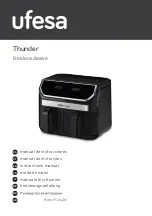
2-18
Vent system chart 1 - rigid metal vent only
Vent system chart 2 - rigid metal vent used with a
maximum of 8 ft (2.4 m) flexible metal vent
Number of
90º turns
or elbows
Type of
vent
Box or
louvered
hoods
Angled
hoods
0
Rigid metal
174 ft (53.0 m)
168 ft (51.2 m)
1
Rigid metal
164 ft (50.0 m)
158 ft (48.0 m)
2
Rigid metal
154 ft (46.9 m)
148 ft (45.1 m)
3
Rigid metal
145 ft (44.2 m)
139 ft (42.4 m)
4
Rigid metal
137 ft (41.8 m)
131 ft (39.9 m)
Number of
90º turns
or elbows
Type of
vent
Box or
louvered
hoods
Angled
hoods
0
Rigid metal
144 ft (43.9 m)
138 ft (42.1 m)
1
Rigid metal
134 ft (40.8 m)
128 ft (39.0 m)
2
Rigid metal
125 ft (38.1 m)
119 ft (36.3 m)
3
Rigid metal
117 ft (35.7 m)
111 ft (33.8 m)
INSTALL VENT SYSTEM
The Vent system charts provide venting re-
quirements that will help to achieve the best
drying performance.
Vent System Charts
MAKE GAS CONNECTION
1. Remove the red cap from the gas pipe.
Move the dryer close to its final location.
2. Using a wrench to tighten, connect the gas
supply to the dryer. Use pipe-joint com-
pound on the threads of all nonflared male
fittings. If flexible metal tubing is used, be
sure there are no kinks.
NOTE:
For LP gas connections, you must use
pipe-joint compound resistant to the action of
LP gas. Do not use TEFLON
®†
tape.
†®
TEFLON is a registered trademark of E.I. Du Pont
De Nemours and Company.
A combination of pipe fittings must be used
to connect the dryer to the existing gas line.
Shown is a recommended connection. Your
connection may be different, according to the
supply line type, size and location.
A. Closed valve
B. Open valve
A
B
3. Open the shutoff valve in the supply line.
The valve is open when the handle is par-
allel to the gas pipe.
A.
³⁄
8
³⁄
8
³⁄
8
³⁄
8
³⁄
8
" flexible gas connector
B.
" dryer pipe
C.
" to
" pipe elbow
D.
" pipe-to-flare adapter fitting
A
B
C
D
4. Test all connections by brushing on an ap-
proved noncorrosive leak-detection solu-
tion. Bubbles will show a leak. Correct any
leak found.
WARNING
Excessive Weight Hazard
Use two or more people to move and
install dryer.
Failure to do so can result in back or
other injury.
1. Position the dryer so that the rear of the dry-
er is within 4 ft (1.2 m) of its final location.
2. Install exhaust hood. Use caulking com-
pound to seal exterior wall opening around
exhaust hood.
3. Connect vent to exhaust hood. Vent must
fit inside exhaust hood. Secure vent to ex-
haust hood with 4
˝
(10.2 cm) clamp.
4. Run vent to dryer location. Use the straight-
est path possible. See “Determine vent path,”
page 2-17. Avoid 90º turns. Use clamps to
seal all joints. Do not use duct tape, screws
or other fastening devices that extend into
the interior of the vent to secure vent.
Содержание KHEV01RSS - Pro Line Plus Electric Dryer
Страница 112: ......
















































